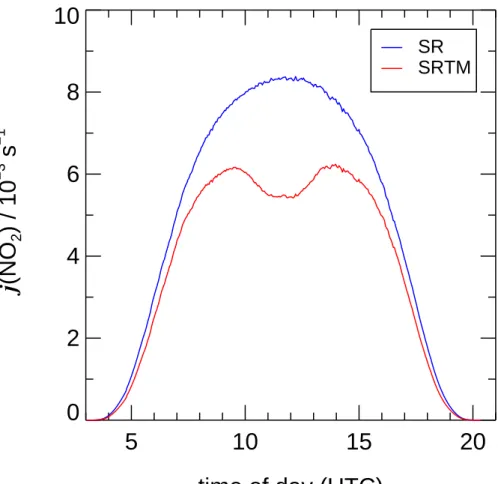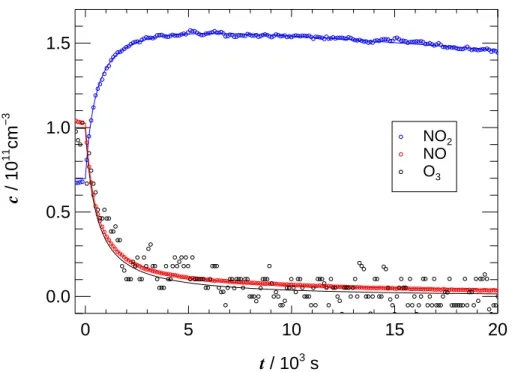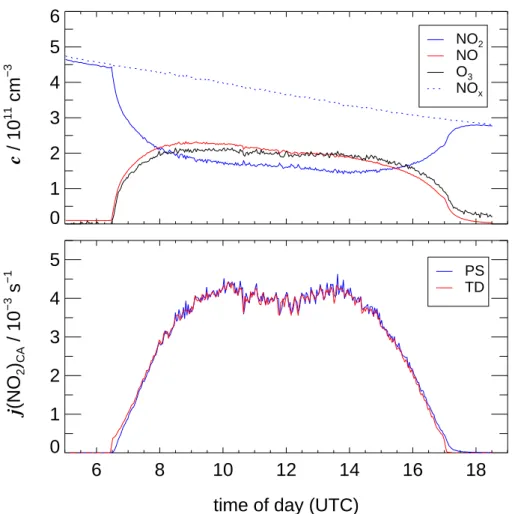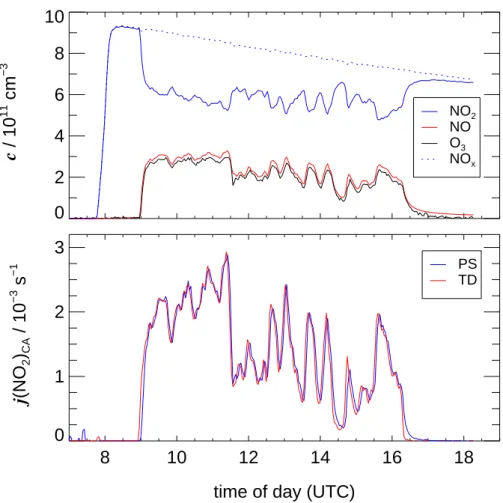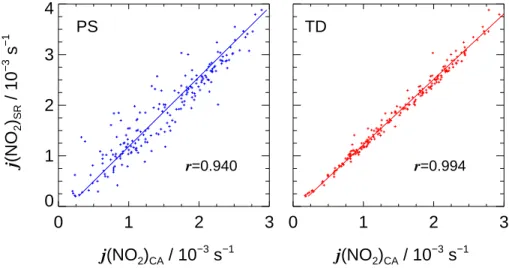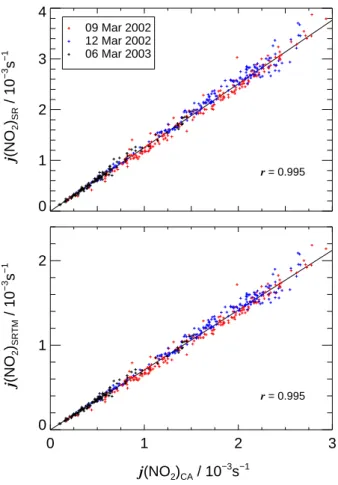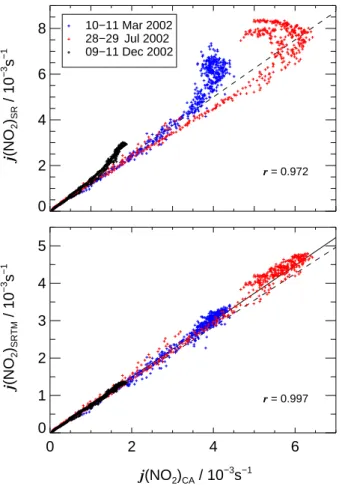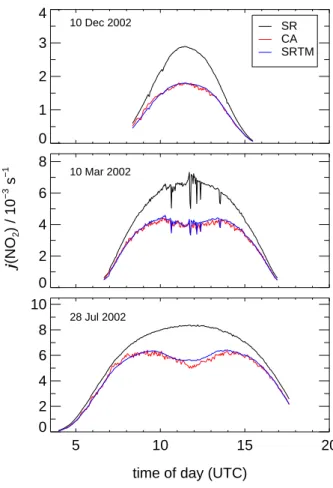HAL Id: hal-00301548
https://hal.archives-ouvertes.fr/hal-00301548
Submitted on 8 Dec 2004HAL is a multi-disciplinary open access
archive for the deposit and dissemination of sci-entific research documents, whether they are pub-lished or not. The documents may come from teaching and research institutions in France or abroad, or from public or private research centers.
L’archive ouverte pluridisciplinaire HAL, est destinée au dépôt et à la diffusion de documents scientifiques de niveau recherche, publiés ou non, émanant des établissements d’enseignement et de recherche français ou étrangers, des laboratoires publics ou privés.
Actinometric measurements of NO2 photolysis
frequencies in the atmosphere simulation chamber
SAPHIR
B. Bohn, F. Rohrer, T. Brauers, A. Wahner
To cite this version:
B. Bohn, F. Rohrer, T. Brauers, A. Wahner. Actinometric measurements of NO2 photolysis frequencies in the atmosphere simulation chamber SAPHIR. Atmospheric Chemistry and Physics Discussions, European Geosciences Union, 2004, 4 (6), pp.8141-8170. �hal-00301548�
ACPD
4, 8141–8170, 2004 SAPHIR actinometry B. Bohn et al. Title Page Abstract Introduction Conclusions References Tables Figures J I J I Back CloseFull Screen / Esc
Print Version Interactive Discussion
EGU Atmos. Chem. Phys. Discuss., 4, 8141–8170, 2004
www.atmos-chem-phys.org/acpd/4/8141/ SRef-ID: 1680-7375/acpd/2004-4-8141 European Geosciences Union
Atmospheric Chemistry and Physics Discussions
Actinometric measurements of NO
2
photolysis frequencies in the atmosphere
simulation chamber SAPHIR
B. Bohn, F. Rohrer, T. Brauers, and A. Wahner
Institut f ¨ur Chemie und Dynamik der Geosph ¨are II: Troposph ¨are, Forschungszentrum J ¨ulich, 52425 J ¨ulich, Germany
Received: 25 October 2004 – Accepted: 2 December 2004 – Published: 8 December 2004 Correspondence to: B. Bohn (b.bohn@fz-juelich.de)
ACPD
4, 8141–8170, 2004 SAPHIR actinometry B. Bohn et al. Title Page Abstract Introduction Conclusions References Tables Figures J I J I Back CloseFull Screen / Esc
Print Version Interactive Discussion
EGU
Abstract
The simulation chamber SAPHIR at Forschungszentrum J ¨ulich has UV permeable teflon walls facilitating atmospheric photochemistry studies under the influence of natu-ral sunlight. Because the internal radiation field is strongly affected by construction ele-ments, we use external, radiometric measurements of spectral actinic flux and a model
5
to calculate mean photolysis frequencies for the chamber volume (Bohn and Zilken, 2004). In this work we determine NO2 photolysis frequencies j (NO2) within SAPHIR using chemical actinometry by injecting NO2and observing the chemical composition during illumination under various external conditions. In addition to a photo-stationary approach, a time-dependent method was developed to analyse the data. These
mea-10
surements had two purposes. Firstly, to check the model predictions with respect to diurnal and seasonal variations in the presence of direct sunlight and secondly to ob-tain an absolute calibration factor for the combined radiometry-model approach. We obtain a linear correlation between calculated and actinometric j (NO2). A calibration factor of 1.34±0.10 is determined, independent of conditions in good approximation.
15
This factor is in line with expectations and can be rationalised by internal reflections within the chamber. Taking into account the uncertainty of the actinometric j (NO2), an accuracy of 13% is estimated for the determination of j (NO2) in SAPHIR. In separate dark experiments a rate constant of (1.93±0.12)×10−14cm3s−1was determined for the NO+O3reaction at 298 K using analytical and numerical methods of data analysis.
20
1. Introduction
Photolysis processes are very important for atmospheric chemistry. For example, pho-tolysis of NO2followed by reaction of O-atoms with O2is a major source of tropospheric ozone:
NO2+ hν(λ ≤ 420 nm) → O(3P)+ NO (1)
ACPD
4, 8141–8170, 2004 SAPHIR actinometry B. Bohn et al. Title Page Abstract Introduction Conclusions References Tables Figures J I J I Back CloseFull Screen / Esc
Print Version Interactive Discussion
EGU
O(3P)+ O2→ O3 (2)
Photolysis frequencies (j ) are first-order rate constants quantifying the rate of photoly-sis processes in terms of a relative concentration change of the precursor molecule (or a photo-product). For Reaction (1):
j (NO2)= − 1 [NO2]
d[NO2]
dt (3)
5
Of course, Eq. (3) is valid only in the absence of other NO2loss or formation processes and cannot be used to determine j (NO2) from NO2 concentration measurements in complex, natural systems. In the troposphere for example, NO2 loss by photolysis is partly compensated by reaction of NO with O3or peroxy radicals (RO2):
NO+ O3→ NO2+ O2 (4)
10
NO+ RO2→ NO2+ RO (5)
However, in simpler artificial chemical systems, photolysis frequencies can be deter-mined by monitoring the gas-phase composition. This technique is well established since many years and referred to as chemical actinometry. A recent study byShetter et al. (2003) gives an overview of previous work concerned with actinometric j (NO2)
15
measurements. In the case of Reaction (1), a quartz flow-tube exposed to sunlight can be used where the carrier gas is loaded with a known concentration of NO2. Photolysis frequencies are then determined from the increase of NO concentration as a function of exposure time.
The complex instrumentation needed to obtain a single photolysis frequency is a
20
drawback of chemical actinometry for field measurements. As a consequence, spec-troradiometry is a useful alternative where solar spectral actinic flux Fλ is measured and photolysis frequencies are calculated using the absorption cross sections σ of the
ACPD
4, 8141–8170, 2004 SAPHIR actinometry B. Bohn et al. Title Page Abstract Introduction Conclusions References Tables Figures J I J I Back CloseFull Screen / Esc
Print Version Interactive Discussion
EGU precursor molecule and the quantum yield φ of the photo-products (e.g.Hofzumahaus
et al.,1999). In the case of Reaction (1):
j (NO2)= Z
σ(NO2) φ(O3P) Fλ(λ) dλ (6)
Recent comparisons show that chemical actinometry and spectroradiometry give consistent results within better than 10% with respect to NO2and O3photolyses (Kraus
5
et al., 2000; Shetter et al., 2003; Hofzumahaus et al., 2004). In the case of NO2 photolysis the agreement is even within 5% in a study from our laboratory (Kraus et al., 2000) using molecular data σ(NO2) and φ(O3P) by Merienne et al. (1995) and Troe (2000), respectively, as recently recommended byAtkinson et al.(2004).
The spectroradiometric approach is not as straightforward for the atmosphere
sim-10
ulation chamber SAPHIR at Forschungszentrum J ¨ulich (Fig.1). SAPHIR was created to study tropospheric chemistry unaffected by transport processes at ambient levels of trace gas concentrations. As in the real troposphere, chemistry is driven by photolysis of trace gases induced by natural sunlight entering the chamber through UV-permeable teflon walls. However, the radiation field inside the chamber is complex and radiometric
15
point measurements are not representative for the reactor as a whole.
In a preceding paper (Bohn and Zilken, 2004) a model was developed predicting time-dependent, volume-mean photolysis frequencies for the simulation chamber. This approach will be denoted SRTM (SAPHIR Radiative Transmission Model) in the follow-ing. The model uses external spectroradiometric measurements of direct and diffuse
20
solar actinic flux as input and considers the influence of opaque chamber elements and chamber teflon walls. Basically, time and wavelength dependent, relative scaling factors for the external diffuse and direct fluxes are derived. Time dependent effects are most pronounced for direct sunlight while wavelength dependence is induced by the chamber walls leading to an increase of transmission with wavelength by about
25
20% in the range 300–400 nm. As an example for the nature and magnitude of the predicted effects, Fig.2shows a comparison of j (NO2) measured externally by a spec-troradiometer (SR) and calculated by SRTM. However, so far SRTM calculations are
ACPD
4, 8141–8170, 2004 SAPHIR actinometry B. Bohn et al. Title Page Abstract Introduction Conclusions References Tables Figures J I J I Back CloseFull Screen / Esc
Print Version Interactive Discussion
EGU on a relative basis and need confirmation on an absolute level. Moreover, the predicted
time-dependencies have to be checked experimentally before this method can be used for routine measurements of photolysis frequencies in SAPHIR, as intended.
In this work we present measurements of j (NO2) using the simulation chamber as a chemical actinometer. This is achieved by injecting NO2 into the clean chamber.
5
Upon illumination, photolysis of NO2 leads to formation of NO and O3 (Reactions 1 and 2). After a delay dependent on experimental conditions, a photochemical equi-librium establishes where losses of NO2 by photolysis are compensated by the NO + O3 reaction. From the equilibrium concentrations of NO, O3 and NO2 j (NO2) can be calculated. In addition we consider deviations from photochemical equilibrium by
10
a time-dependent approach to derive photolysis frequencies under variable external conditions. The actinometric j (NO2) are then compared with radiometric SRTM pre-dictions. Clear sky conditions at different seasons as well as overcast conditions were investigated. Furthermore, the rate constant of Reaction (4) is determined in separate dark-experiments under the experimental conditions in SAPHIR.
15
2. Experimental
2.1. Simulation chamber
The simulation chamber SAPHIR consists of a double-wall teflon (FEP) tube held in a steel frame (Fig.1). FEP film has been selected because it is chemically inert and UV permeable. The inner tube is used as a reactor for simulation experiments. It has a
20
volume of 270 m3 and can be flushed with dry or wet synthetic air (purity 99.9999%) loaded with a variety of trace gases if required. The space between the inner and the outer tube (≈0.1 m) is permanently flushed with synthetic air to prevent diffusion of gases from outside. Typical leak rates for the reactor are 3–8 m3 h−1. The chamber can be covered by a movable, opaque roof construction within about 1 min and vice
25
ACPD
4, 8141–8170, 2004 SAPHIR actinometry B. Bohn et al. Title Page Abstract Introduction Conclusions References Tables Figures J I J I Back CloseFull Screen / Esc
Print Version Interactive Discussion
EGU given by Brauers et al. (2004)1andRohrer et al.(2004).
2.2. Actinometry
In actinometric experiments typically 20–50 ppb of NO2(500 ppm in N2, Messer Gries-heim) were injected into the dark chamber filled with dry air in the absence of any VOCs (≤2 ppt, GC analysis). After about 30 min delay to allow for homogeneous mixing, the
5
roof was opened and photochemistry started notable by a decrease of NO2 concen-tration and a corresponding increase of NO and O3concentrations. Measurements of trace gases were made close to the centre of the chamber 1 m above chamber ground. Ozone was measured by a commercial UV absorption instrument (Ansyco, O3 41M) with a precision of 0.3–0.5 ppb and an accuracy of 3%. NO and NO2were measured by
10
a chemiluminescence technique with a modified commercial instrument (Eco Physics, TR 780). The precisions are about 5 ppt and 10 ppt at NO=0 and NO2=0, respectively, and about 0.1% at 50 ppb for both compounds. NO2is photolytically converted to NO prior to detection (Eco Physics, PLC 760). Absolute accuracy and the efficiency of the photolytic converter are checked by regular comparisons with certified NO test gas
15
(2 ppm NO in N2, BOC) and by gas phase titrations of NO with O3. The accuracy is 5% for NO, 10% for NO2 and 5% for the NO/NO2 ratio. Measurements were made every 50 s with regular switching between NO and NO2 measurement modes. More details of this technique are given byRohrer et al.(1998). Temperature and pressure measurements were made using an ultrasonic anemometer (Metek, USA-1) via sound
20
velocity and a capacity pressure gauge (Setra Systems, 270), respectively. Tempera-ture within the reactor cannot be controlled. It typically lies about 0–5 K above ambient temperature, dependent on conditions.
1
Brauers, T., Johnen, F.-J., H ¨aseler, R., Rohrer, F., Bohn, B., Tillmann, R., Rodriguez-Bares, S., and Wahner, A.: The atmosphere simulation chamber SAPHIR: A tool for the investigation of photochemistry, in preparation, 2004.
ACPD
4, 8141–8170, 2004 SAPHIR actinometry B. Bohn et al. Title Page Abstract Introduction Conclusions References Tables Figures J I J I Back CloseFull Screen / Esc
Print Version Interactive Discussion
EGU 2.3. Spectroradiometry and model calculations
During the actinometric chamber experiments solar actinic flux was measured exter-nally by a spectroradiometer on the roof of a nearby building. Spectra were recorded about every 2 min in the range 280–420 nm with a distinction of diffuse and direct sun-light by using a shadow ring. More details concerning these measurements are given
5
by Hofzumahaus et al. (1999) and Bohn and Zilken (2004). From these measure-ments solar actinic flux spectra and photolysis frequencies are derived for the simula-tion chamber using SRTM calculasimula-tions (Bohn and Zilken,2004).
3. Results and discussion
3.1. Rate constant of the O3+NO reaction
10
The rate constant of Reaction (4) is essential to determine j (NO2) by actinometry. k4 can be obtained in separate dark-experiments by closing the roof of SAPHIR after the actinometric experiments described in Sect.2.2. NO subsequently reacts with O3 forming NO2until one or both reactants are used up. Although the chemical system is simple, data analysis is not straightforward because starting concentrations of NO and
15
O3 are not identical. As a consequence, dilution is affecting the reactants differently. Although dilution is slow (≤10−5s−1), it cannot be neglected for the dark reactions because the decay of the reactants takes hours at the concentration levels used. On the other hand, dilution can be treated as a first-order loss process for any species because the chamber behaves like an ideal stirred reactor (Brauers et al., 20041).
20
The reason for the different starting concentrations of NO and O3 is the presence of small amounts of HONO produced by the chamber walls at illumination (Rohrer et al.,2004). The formation rate of HONO is usually small at dry conditions (≈50 ppt h−1) but photolysis of HONO leads to a small net production of NO. On the other hand, after a longer period of illumination there is a tendency towards a net O3 production,
ACPD
4, 8141–8170, 2004 SAPHIR actinometry B. Bohn et al. Title Page Abstract Introduction Conclusions References Tables Figures J I J I Back CloseFull Screen / Esc
Print Version Interactive Discussion
EGU probably induced by reaction of OH (from HONO photolysis) with traces of VOCs not
accounted for by GC analysis (Rohrer et al.,2004). These interferences are leading to small differences of NO and O3starting concentrations.
In the succeeding two sections, analytical and numerical methods of data analysis will be used to determine k4 from the experimental NO, NO2 and O3 concentration
5
traces.
3.1.1. Analytical solution
The dark-reactions can be described by the following set of differential equations: d[NO]
dt = −k4[NO][O3] − kdil[NO] (7)
d[O3]
dt = −k4[NO][O3] − kdil[O3] (8)
10
d[NO2]
dt = k4[NO][O3] − kdil[NO2] (9)
Here kdil is the first-order rate constant of loss by dilution. Utilising the additional rela-tions:
[NOx]= [NO2]+ [NO] = ([NO2]0+ [NO]0) exp(−kdilt) (10)
[NO] − [O3]= ([NO]0− [O3]0) exp(−kdilt) (11)
15
the system of differential equations can be reduced to a single equation: d[NO]
dt = −k4[NO]{[NO] − ([NO]0− [O3]0) exp(−kdilt)} − kdil[NO] (12) This equation was solved using the solution of Bernoulli’s differential equation:
[NO]= D ([NO]0− [O3]0)
ACPD
4, 8141–8170, 2004 SAPHIR actinometry B. Bohn et al. Title Page Abstract Introduction Conclusions References Tables Figures J I J I Back CloseFull Screen / Esc
Print Version Interactive Discussion
EGU where D= exp(−kdilt). From this solution, NO2 and O3 concentrations can be
calcu-lated by inserting into Eqs. (10) and (11).
Figure 3 shows an example of NO, NO2 and O3 concentration traces after closing the roof of SAPHIR. In the data analysis Eqs. (13) and (10) were fitted simultaneously to NO and NO2 data, respectively, using a Levenberg-Marquardt least-squares fitting
5
procedure. O3 data were not used because of their poorer precision. Five parameters were determined: the starting concentrations [NO]0, [NO2]0 and [O3]0 and the rate constants kdiland k4.
In Table1conditions of four experiments are summarised. Temperatures could not be kept constant and typically decreased by 6–8 K during the experiments. The
tem-10
peratures listed in Table1 are averages from the early periods of the experiments in which the NO concentrations dropped to 10% of the starting concentrations (within about 1–2 h after closing the roof). These temperatures are accurate within about 1 K and were assigned to the rate constants obtained from the fits. However, the temper-atures of Table1are not representative for the later periods of the experiments where
15
temperatures dropped more strongly. The numerical analysis described in the next section therefore uses actual temperatures for the whole period and rate constants k4 are determined in terms of scaling factors with respect to a currently recommended temperature dependent rate expression (Sander et al.,2003):
f4= k4(T )
3.0 × 10−12cm3s−1exp(−1500K/T ) (14)
20
To allow a comparison these scaling factors are also used here to specify the analytical results listed in Table1.
In all four experiments the scaling factors are close to unity within 3%. The average corresponds to a rate constant of 1.98×10−14cm3s−1at 298 K. A 5% error is estimated for the assumption of constant temperatures during the experiments. Together with
25
the uncertainties of the NOx measurements we evaluate a 7% error limit for the rate constant. To check for consistency, dilution rate constants were also determined by
ACPD
4, 8141–8170, 2004 SAPHIR actinometry B. Bohn et al. Title Page Abstract Introduction Conclusions References Tables Figures J I J I Back CloseFull Screen / Esc
Print Version Interactive Discussion
EGU fitting the exponential decay D of Eq. (13) to the NOx data. The kdil are similar within
2% compared to the results obtained by fitting Eq. (13).
3.1.2. Numerical analysis
Equation (13) shows that analytical solutions are getting complex and inflexible even for a fairly simple chemical system. A drawback of Eq. (13) is that dilution and
tem-5
perature are assumed constant during the experiments. Although this is correct in good approximation, the use of measured, time-dependent temperatures and dilution rates calculated from the flow rates of the gas-supplying system (Rohrer et al.,2004) are more appropriate. For that reason a numerical method was used where time-dependent experimental boundary conditions are considered and the system of
dif-10
ferential equations (Eqs.7–9) is solved numerically using EASY (Brauers and Rohrer, 1999) which is an interface for the FACSIMILE integrator with time dependent boundary values and the Levenberg-Marquardt algorithm for fitting. The results of the numerical data analysis are also summarised in Table1. Only three experiments could be anal-ysed because flow rates were not monitored in one of the experiments. The averaged
15
scaling factor corresponds to a rate constant of 1.93×10−14cm3 s−1 at 298 K. Taking into account the uncertainty of the NOx measurements and the reproducibility of the result, we estimate a 6% error limit for this rate constant. Both methods of data anal-ysis yield consistent results with averaged scaling factors very close to unity within 2%. Our data therefore confirm the recommendation bySander et al.(2003) (Eq.14,
20
k4(298 K)=1.95×10−14cm3s−1) which will be used in the following experiments aiming at photolysis frequencies. It should be noted that a recently recommended Arrhenius expressions byAtkinson et al.(2004) is lower by 12% at 298 K.
3.2. Photolysis frequencies from trace gas concentrations
The idea behind chamber actinometry is to derive mean photolysis frequencies from
25
cham-ACPD
4, 8141–8170, 2004 SAPHIR actinometry B. Bohn et al. Title Page Abstract Introduction Conclusions References Tables Figures J I J I Back CloseFull Screen / Esc
Print Version Interactive Discussion
EGU ber, photolysis of NO2leads to formation of O3and NO. On the other hand, reaction of
these photo-products regenerates NO2. A photochemical equilibrium has established if loss and formation processes compensate each other, e.g. in the case of NO2: d[NO2]
dt = −j(NO2)[NO2]+ k4[O3][NO]= 0 (15)
Since k4 is known, j (NO2) can be calculated from the equilibrium concentrations of
5
NO2, O3and NO:
j (NO2)PS= k4[O3][NO]
[NO2] (16)
In this photo-stationary (PS) approach losses by dilution are neglected and j (NO2) is assumed constant. Dilution is indeed too slow to influence the photochemical equilib-rium with j (NO2) typically more than two orders of magnitude greater than kdil.
10
The PS approach remains reasonable if j (NO2) changes slowly compared to the relaxation time of the photochemical system. This is the case for example under clear-sky conditions where j (NO2) exhibits a smooth change in the course of a day. However, under cloudy conditions j (NO2) often changes rapidly which leads to a departure from photochemical equilibrium. As a consequence, a different, time-dependent approach
15
(TD) was used to retrieve j (NO2) from the trace gas concentrations and their changes. The differential equation describing the time-dependence of the NO concentration, d[NO]
dt = −k4[NO][O3]+ j(NO2)TD[NO2] (17)
can be rearranged accordingly:
j (NO2)TD= j(NO2)PS+ 1 [NO2] d [NO] d t ≈ j (NO2)PS+ 1 [NO2] ∆ [NO] ∆ t (18) 20
As an example Fig. 4 shows the variation of trace gas concentrations in a typical actinometric experiment on a clear sky day (10 March 2002). After a short delay upon
ACPD
4, 8141–8170, 2004 SAPHIR actinometry B. Bohn et al. Title Page Abstract Introduction Conclusions References Tables Figures J I J I Back CloseFull Screen / Esc
Print Version Interactive Discussion
EGU opening the roof, a photochemical equilibrium establishes and concentrations change
smoothly in the course of the day. Accordingly, also the actinometric photolysis fre-quencies j (NO2)CA show a smooth change with a local minimum at noon caused by chamber construction elements. Except from short periods directly after opening and closing the roof of SAPHIR, the j (NO2)CA based on photo-stationary (PS) and
time-5
dependent (TD) calculations look very similar.
The concentration changes in Fig.4are superposed by continuous dilution as repro-duced by NOx. Although the experiment starts with a small residue of NO left behind from an actinometric experiment on the previous day (Fig.5), there is a slight built-up of O3resulting in a residue of about 1 ppb at the end of the day. These imbalances were
10
explained qualitatively in Sect.3.1. However, the influence of the underlying processes on the photochemical equilibrium are insignificant. For example, if a formation rate of 1 ppb/h of O3 is assumed as an upper limit and attributed to NO2 photolysis preceded by oxidation of NO by HO2 (or RO2) radicals, the contribution to the continuous, total NO2formation (mainly by NO+O3) is is well below 1%.
15
Figure5shows an experiment on an overcast day (9 March 2002) where occasion-ally photolysis frequencies changed rapidly. This results in strong changes of trace gas concentrations and sporadic deviations from photochemical equilibrium as indicated by the differences of actinometric PS and TD photolysis frequencies. The PS data clearly show a delayed response to the concentration changes. The difference between the
20
data sets is more obvious in Fig.6where the j (NO2)CAare plotted against radiometric photolysis frequencies j (NO2)SRmeasured outside of SAPHIR by the spectroradiome-ter. Under overcast conditions there is a linear correlation between the data (Sect.4). However, the quality of the correlation improves significantly using the time-dependent calculations rather than the photo-stationary approach, as reflected in the correlation
25
coefficients. In the following we will use the time-dependent approach for all types of conditions.
ACPD
4, 8141–8170, 2004 SAPHIR actinometry B. Bohn et al. Title Page Abstract Introduction Conclusions References Tables Figures J I J I Back CloseFull Screen / Esc
Print Version Interactive Discussion
EGU
4. Comparison of actinometry with SRTM predictions
4.1. Overcast conditions
If a constant sky radiance distribution is assumed under overcast conditions, a linear correlation between photolysis frequencies measured externally by radiometry and in-ternally by actinometry is expected. Figure7shows a plot of external j (NO2)SRagainst
5
j (NO2)CAfor three overcast days. The correlation of the data is excellent with a linear correlation coefficient of 0.995. The mean ratio j(NO2)CA/j (NO2)SR is 0.80±0.05, i.e. the radiometric data have to be scaled down by this factor to obtain mean chamber values. A mean ratio is used here rather than a linear regression to give equal weight to all data points irrespective of the j (NO2) values. The procedure is justified because
10
deviations from the mean ratio are normally-distributed in good approximation with a standard deviation stated above.
Of course, also SRTM predicts a linear relationship between j (NO2)CAand j (NO2)SR. Based on a time-independent SOC sky radiance distribution (standard overcast sky, Grant and Heisler, 1997), scaling factors are calculated theoretically with very minor
15
time-dependent variations introduced by wavelength correction. Accordingly, the plot of j (NO2)SRTM against j (NO2)CA in the lower panel of Fig. 7 looks virtually identical and a similar correlation coefficient is obtained. However, the scaling factor necessary to convert SRTM to mean SAPHIR values is different: 1.41±0.09. In contrast to the data measured externally, the model data have to be scaled up because the SRTM
20
calculations are merely dealing with attenuation of radiation by the opaque chamber construction and the limited transmission of the chamber walls. The scaling factor corresponds to the chamber specific quantity hc>1 introduced in SRTM which is ra-tionalised by internal reflections within SAPHIR. The hc obtained here is close to an estimate hc≈1.3, independent of wavelength, based on 4π radiometric measurements
25
inside the chamber (Bohn and Zilken,2004). The difference can be explained by an underestimation of chamber wall transmission in the theoretical model. The results of
ACPD
4, 8141–8170, 2004 SAPHIR actinometry B. Bohn et al. Title Page Abstract Introduction Conclusions References Tables Figures J I J I Back CloseFull Screen / Esc
Print Version Interactive Discussion
EGU the data analysis for overcast conditions are summarised in Table2.
4.2. Clear sky conditions
Under clear sky conditions the SRTM model is predicting strong time-dependent cham-ber effects. In accordance with this, the upper panel of Fig. 8shows a much poorer correlation between external j (NO2)SRand internal j (NO2)CAfor a total of seven clear
5
sky days of different seasons. Application of the SRTM model significantly improves this correlation by removing most of the diurnal and seasonal deviations as shown in the lower panel of Fig.8. The mean ratio j (NO2)CA/j (NO2)SRTM yields hc=1.34±0.08. Table2gives a summary of results for different seasons. Within experimental scatter, there is no seasonal dependence of scaling factors recognisable. Moreover, although
10
the agreement is not perfect, within error limits the hcis similar for overcast conditions. The SRTM calculations of Fig. 8 are based on an empirical, analytical distribution of diffuse UV-A sky radiance under clear sky conditions (Grant et al.,1997). This is considered the best attempt if no information on radiance distributions is available. However, the quality of the correlation and the factor hc hardly change if the
time-15
independent SOC radiance distribution is used also for clear sky conditions. The rea-son for this are compensating effects concerning the shadow ring correction and the scaling factors for diffuse sky radiation (Bohn and Zilken,2004). Using the SOC radi-ance distribution also for clear sky conditions has two practical benefits. Firstly, less time is needed for the model calculations because a large fraction of computing time is
20
concerned with time-dependent shadow ring corrections and scaling factors of diffuse sky radiation. Secondly, no distinction has to be made within the model between clear sky and overcast conditions.
The effect of neglecting the influence of the chamber walls in the model calcula-tions was also investigated. Bohn and Zilken(2004) already showed that the chamber
25
walls are expected to induce minor time-dependent effects. The largest influence was predicted for direct sunlight during the winter season when the contribution of direct sunlight is low. In accordance with this, the quality of the CA versus SRTM correlations
ACPD
4, 8141–8170, 2004 SAPHIR actinometry B. Bohn et al. Title Page Abstract Introduction Conclusions References Tables Figures J I J I Back CloseFull Screen / Esc
Print Version Interactive Discussion
EGU are still satisfactory if the influence of the chamber walls is neglected (r=0.996). On the
other hand, the factor hc is lower and close to unity (1.03±0.07) showing that the lim-ited transmission of the chamber walls is almost compensated by internal reflections. However, the hc neglecting chamber walls is expected to be wavelength dependent and therefore SRTM calculations including chamber walls are preferred.
5
Taking clear sky and overcast data together and assuming an SOC radiance distri-bution, we obtain a mean scaling factor hc=1.34±0.10 for all conditions, i.e. by the use of external spectroradiometric measurements and the SRTM model we are currently able to determine photolysis frequencies for the simulation chamber within 7–8% of the actinometric reference.
10
4.3. Limitations and possible error sources
As an example of the remaining differences between actinometric and SRTM data, Fig. 9 shows diurnal variations of photolysis frequencies on three clear sky days of different seasons. Spectroradiometric photolysis frequencies measured outside exhibit a familiar, smooth shape with typical diurnal and seasonal variations. In general,
acti-15
nometric j (NO2) data and SRTM predictions agree well within experimental scatter. However, the precision of the actinometric data is poorer, limited mainly by the ozone measurements. This induces part of the uncertainties of the hc. However, there are other possible error sources of more systematic nature which will be discussed in the following.
20
Taking the actinometric j (NO2) representative for the chamber volume, assumes well mixed conditions because the radiation field within the chamber is heterogeneous. Mix-ing properties of the chamber were investigated for different conditions. With opened roof there is convection resulting in complete mixing of an injected trace gas pulse within about 10 min. In the dark this mixing time is prolonged by a factor of about three.
25
Operation of two mixing fans shortens the mixing time by a factor of about four. Switch-ing on and off the mixing fans produced no significant change of the measured trace gas concentrations in an actinometric experiment under clear sky conditions where
lo-ACPD
4, 8141–8170, 2004 SAPHIR actinometry B. Bohn et al. Title Page Abstract Introduction Conclusions References Tables Figures J I J I Back CloseFull Screen / Esc
Print Version Interactive Discussion
EGU cal shadowing should be most pronounced. This shows that mixing within SAPHIR is
fast enough to prevent formation of concentration gradients caused by heterogeneous illumination, at least for the photochemical system studied in this work. Nevertheless, small-scale mixing effects can reduce the precision of the actinometric measurements. Changes of temperature were not considered in the SRTM calculations where
5
T=298 K was assumed. Using a linear interpolation of recommended, temperature dependent data of absorption cross sections and quantum yields of NO2 (Atkinson et al., 2004), a temperature coefficient of about 0.08% K−1 for j (NO2) is estimated. This has a negligible effect (<1%) on the hcscaling factors listed in Table2.
There seems to be a slight underestimation of the actinometric data by the model
10
calculations in the morning. Such an effect can be explained by different degrees of staining of the chamber foil exposed to atmospheric conditions. Staining can also explain the differences in the scaling factors hc obtained for overcast and clear sky conditions. Model calculations seem to over-predict chamber values when direct sun-light is incident from southerly directions passing the upper, more horizontal parts of
15
the chamber walls predestined for staining. However, such effects are hard to assess quantitatively within the model.
With respect to the model, the assumption of a constant SOC sky radiance distri-bution under overcast conditions is certainly not always matched by reality. Azimuthal variations of sky radiance can produce changes in the actinometric j (NO2) not
no-20
ticed by the external radiometric measurement. Under clear sky conditions changes of aerosol load will produce variations in sky radiance distributions. Thus, the model input can be improved by a measurement of sky radiance distributions as indicated byBohn and Zilken (2004).
The SRTM model postulates an effective internal amplification of radiation,
consid-25
ered quantitatively by hc. This amplification is assumed independent of direction of incidence. Moreover, scattering processes at the chamber walls are not explicitly in-cluded in the model approach. Both deficiencies can lead to additional time-dependent effects. It is therefore not surprising that model predictions of photolysis frequencies
ACPD
4, 8141–8170, 2004 SAPHIR actinometry B. Bohn et al. Title Page Abstract Introduction Conclusions References Tables Figures J I J I Back CloseFull Screen / Esc
Print Version Interactive Discussion
EGU for single locations within the chamber are not well reproduced by measurements.
Al-though the exact time and durations of shadows casted on a location can be predicted, the quantitative effect of these shadows cannot be reproduced. Qualitatively, the light level is higher than predicted in the shadows and lower outside the shadows which can be explained by scattering of radiation at the chamber walls.
5
It should be noted that with respect to the accuracy of the j (NO2) determination for SAPHIR possible systematic errors of the actinometric reference have to be considered as well. Because the uncertainty of the rate constant k4is dominated by the uncertainty of the NOx measurements these errors are not independent and add to 10% for the photolysis frequencies. Assuming that the errors estimated for SRTM (7–8%) and O3
10
(3%) are independent, a total uncertainty of 13% is evaluated.
5. Conclusions
In this work we have shown that mean j (NO2) photolysis frequencies for the atmo-sphere simulation chamber SAPHIR can be predicted with high accuracy and preci-sion using the SRTM approach described byBohn and Zilken(2004). The remaining
15
differences can be attributed to deficiencies of the model approach and technical prob-lems concerning the condition of the chamber walls. With respect to the actinometric reference measurements, we estimate an accuracy of 7–8% for the j (NO2) based on SRTM, independent of external conditions. No change of hc was found within a pe-riod of one year and regular checks will be made to assure the long-term reliability of
20
the measurements. Taking into account possible systematic errors of the actinometric j (NO2), photolysis frequencies within SAPHIR are accurate within 13%.
In future work the SRTM model and the radiometric input data could be improved as indicated by Bohn and Zilken(2004). Moreover, an actinometric determination of j (O1D) photolysis frequencies within SAPHIR will be developed to check the model
pre-25
dictions concerning wavelength dependence. Ozone measurements of higher preci-sion and the enforcement of well mixed conditions would improve the precipreci-sion and the
ACPD
4, 8141–8170, 2004 SAPHIR actinometry B. Bohn et al. Title Page Abstract Introduction Conclusions References Tables Figures J I J I Back CloseFull Screen / Esc
Print Version Interactive Discussion
EGU accuracy of the actinometric j (NO2) measurements. Under these conditions, smaller
systematic effects caused by deficient model assumptions could be investigated. Acknowledgements. The authors thank A. Hofzumahaus for useful discussions. Financial sup-port by the Helmholtz-Gemeinschaft (B. Bohn) is gratefully acknowledged.
References
5
Atkinson, R., Baulch, D. L., Cox, R. A., Crowley, J. N., Hampson, R. F., Hynes, R. G., Jenkin, M. E., Rossi, M. J., and Troe, J.: Evaluated kinetic and photochemical data for atmospheric chemistry: Part 1 – gas phase reactions of Ox, HOx, NOxand SOx species, Atmos. Chem. Phys., 4, 1461–1738, 2004,
SRef-ID: 1680-7324/acp/2004-4-1461. 8144,8150,8156
10
Bohn, B. and Zilken, H.: Model-aided radiometric determination of photolysis frequencies in a sunlit atmosphere simulation chamber, Atmos. Chem. Phys. Discuss., 4, 6967–7010, 2004,
SRef-ID: 1680-7375/acpd/2004-4-6967. 8142,8144,8147,8153,8154,8156,8157,8163
Brauers, T. and Rohrer, F.: Easy AtmoSpheric Chemistry: Manual Vers 2.9, available athttp:
//www.fz-juelich.de/icg/icg-ii/easy doc/, 1999. 8150
15
Grant, R. H. and Heisler, G. M.: Obscured overcast sky radiance distributions for ultraviolet and photosynthetically active radiation, J. Appl. Meteorol., 36, 1336–1345, 1997. 8153
Grant, R. H., Heisler, G. M., and Gao, W.: Clear sky radiance distributions in ultraviolet wave-length bands, Theo. Appl. Climatol., 56, 123–135, 1997. 8154
Hofzumahaus, A., Kraus, A., and M ¨uller, M.: Solar actinic flux spectroradiometry: A technique
20
for measuring photolysis frequencies in the atmosphere, Appl. Opt., 38, 4443–4460, 1999.
8144,8147
Hofzumahaus, A., Lefer, B. L., Monks, P. S., Hall, S. R., Kylling, A., Mayer, B., Shetter, R. E., Junkermann, W., Bais, A., Calvert, J. G., Cantrell, C. A., Madronich, S., Edwards, G. D., Kraus, A., M ¨uller, M., Bohn, B., Schmitt, R., Johnston, P., McKenzie, R., Frost, G. J., Griffioen,
25
E., Krol, M., Martin, T., Pfister, G., R ¨oth, E. P., Ruggaber, A., Swartz, W. H., Lloyd, S. A., and VanWeele, M.: Photolysis frequency of O3to O(1D): Measurement and modelling during the international photolysis frequency measurement and modelling intercomparision (IPMMI), J. Geophys. Res., 109, D8, D08S90, doi:10.1029/2003JD004333, 2004. 8144
ACPD
4, 8141–8170, 2004 SAPHIR actinometry B. Bohn et al. Title Page Abstract Introduction Conclusions References Tables Figures J I J I Back CloseFull Screen / Esc
Print Version Interactive Discussion
EGU Kraus, A., Rohrer, F., and Hofzumahaus, A.: Intercomparison of NO2 photolysis frequency
measurements by actinic flux spectroradiometry and chemical actinometry during JCOM97, Geophys. Res. Lett., 27, 1115–1118, 2000. 8144
Merienne, M. F., Jenouvrier, A., and Coquart, B.: The NO2absorption spectrum: 1. Absorption cross-sections at ambient temperature in the 300–500 nm region, J. Atmos. Chem., 20, 281–
5
297, 1995. 8144
Rohrer, F., Br ¨uning, D., Grobler, E. S., Weber, M., Ehhalt, D. H., Neubert, R., Sch ¨ussler, W., and Levine, I.: Mixing Ratios and photostationary state of NO and NO2observed during the POPCORN field campaign at a rural site in Germany, J. Atmos. Chem., 31, 119–137, 1998.
8146
10
Rohrer, F., Bohn, B., Brauers, T., Br ¨uning, D., Johnen, F.-J., Wahner, A., and Kleffmann, J.: Characterisation of the photolytic HONO source in the atmosphere simulation chamber SAPHIR, Atmos. Chem. Phys. Discuss., 4, 7881–7915, 2004,
SRef-ID: 1680-7375/acpd/2004-4-7881. 8146,8147,8148,8150
Sander, S. P., Friedl, R. R., Ravishankara, A. R., Golden, D. M., Kolb, C. E., Kurylo, M. J.,
15
Huie, R. E., Orkin, V. L., Molina, M. J., Moortgat, G. K., and Finlayson-Pitts, B. J.: Chemical Kinetics and Photochemical Data for Use in Atmospheric Studies, Evaluation Number 14, JPL Publ. 02–25, 2003. 8149,8150
Shetter, R. E., Junkermann, W., Swartz, W. H., Frost, G. J., Crawford, J. H., Lefer, B. L., Barrick, J. D., Hall, S. R., Hofzumahaus, A., Bais, A., Calvert, J. G., Cantrell, C. A., Madronich, S.,
20
M ¨uller, M., Kraus, A., Monks, P. S., Edwards, G. D., McKenzie, R., Johnston, P., Schmitt, R., Griffioen, E., Krol, M., Kylling, A., Dickerson, R. R., Lloyd, S. A., Martin, T., Gardiner, B., Mayer, B., Pfister, G., R ¨oth, E. P., Koepke, P., Ruggaber, A., Schwander, H., and van Weele, M.: Photolysis frequency of NO2: Measurement and modelling during the international pho-tolysis frequency measurement and modelling intercomparision (IPMMI), J. Geophys. Res.,
25
108, D16, 8544, doi:10.1029/2002JD002932, 2003. 8143,8144
Troe, J.: Are primary quantum yields of NO2 photolysis at λ ≤398 nm smaller than unity?, Z. Phys. Chem., 214, 573–581, 2000. 8144
ACPD
4, 8141–8170, 2004 SAPHIR actinometry B. Bohn et al. Title Page Abstract Introduction Conclusions References Tables Figures J I J I Back CloseFull Screen / Esc
Print Version Interactive Discussion
EGU
Table 1. Approximate NO and NO2 starting concentrations ([O3]0≈[NO]0), experiment dura-tions, temperatures, and fitted scaling factors f4(Eq.14) from four dark-experiments investigat-ing Reaction (4). Scaling factors using analytical and numerical data analysis are given.
[NO]0a [NO2]0a time/h T /Kb f4c f4d
1.1 0.7 6 295 1.017 –e 3.0 5.0 3 293 1.009 0.956 1.1 0.5 6 295 1.028 1.022 0.4 0.3 6 298 1.003 0.986 average 1.014±0.014 0.988±0.034 a
Units are 1011cm−3,bmean temperature at early stage of experiments (see text),canalytical result,dnumerical result,eno flow rate measurements available
ACPD
4, 8141–8170, 2004 SAPHIR actinometry B. Bohn et al. Title Page Abstract Introduction Conclusions References Tables Figures J I J I Back CloseFull Screen / Esc
Print Version Interactive Discussion
EGU
Table 2. Linear correlation coefficients r and chamber scaling factors hcfrom a comparison of SRTM and actinometric j (NO2) data for overcast and clear sky conditions assuming different sky radiance distributions (see text). Error bars correspond to 1σ standard deviations. The results using model inputs considered most realistic are given in bold font.
radiance distribution UV-A SOC
data points r hc r hc overcast conditions 9 March 2002 196 – 0.994 1.44±0.09 12 March 2002 170 – 0.991 1.38±0.06 6 March 2003 118 – 0.995 1.41±0.09 all data 484 – 0.995 1.41±0.09
clear sky conditions
9–11 Dec. 2002 481 0.997 1.35±0.08 0.997 1.30±0.09 10–11 March 2002 542 0.994 1.35±0.08 0.993 1.33±0.09 28–29 July 2002 514 0.996 1.31±0.07 0.995 1.31±0.08 all data 1537 0.997 1.34±0.08 0.996 1.31±0.09 all conditions all data 2021 – 0.997 1.34±0.10
ACPD
4, 8141–8170, 2004 SAPHIR actinometry B. Bohn et al. Title Page Abstract Introduction Conclusions References Tables Figures J I J I Back CloseFull Screen / Esc
Print Version Interactive Discussion
EGU
ACPD
4, 8141–8170, 2004 SAPHIR actinometry B. Bohn et al. Title Page Abstract Introduction Conclusions References Tables Figures J I J I Back CloseFull Screen / Esc
Print Version Interactive Discussion
EGU
5
10
15
20
time of day (UTC)
0
2
4
6
8
10
j
(NO
2) / 10
−3s
− 1SR
SRTM
Fig. 2. Diurnal variation of j (NO2) measured on a clear sky day (28 July 2002) outside the simulation chamber by a spectroradiometer (SR). SRTM predictions for SAPHIR including a preliminary calibration factor of 1.3 (Bohn and Zilken,2004) are shown for comparison.
ACPD
4, 8141–8170, 2004 SAPHIR actinometry B. Bohn et al. Title Page Abstract Introduction Conclusions References Tables Figures J I J I Back CloseFull Screen / Esc
Print Version Interactive Discussion EGU 0 5 10 15 20 t / 103 s 0.0 0.5 1.0 1.5 c / 10 11 cm −3 NO2 NO O3
Fig. 3. Concentration traces of NO2, NO and O3after closing the roof of SAPHIR at t=0. Blue, red, and black lines, respectively, show fits from analytical data analysis using NO and NO2 data.
ACPD
4, 8141–8170, 2004 SAPHIR actinometry B. Bohn et al. Title Page Abstract Introduction Conclusions References Tables Figures J I J I Back CloseFull Screen / Esc
Print Version Interactive Discussion EGU
0
1
2
3
4
5
6
c
/ 10
11cm
−3 NO2 NO O3 NOx6
8
10
12
14
16
18
time of day (UTC)
0
1
2
3
4
5
j
(NO
2)
CA/ 10
− 3s
− 1 PS TDFig. 4. Upper panel: concentration traces of NO2, NO and O3in an actinometric experiment on 10 March 2002 under clear sky conditions. Lower panel: actinometric photolysis frequencies calculated using the photo-stationary (PS) and the time-dependent (TD) approach.
ACPD
4, 8141–8170, 2004 SAPHIR actinometry B. Bohn et al. Title Page Abstract Introduction Conclusions References Tables Figures J I J I Back CloseFull Screen / Esc
Print Version Interactive Discussion EGU 0 2 4 6 8 10 c / 10 11 cm −3 NO2 NO O3 NOx 8 10 12 14 16 18
time of day (UTC) 0 1 2 3 j (NO 2 )CA / 10 − 3 s − 1 PS TD
Fig. 5. Upper panel: concentration traces of NO2, NO and O3in an actinometric experiment on 9 March 2002 under overcast conditions. Lower panel: actinometric photolysis frequencies calculated using the photo-stationary (PS) and the time-dependent (TD) approach.
ACPD
4, 8141–8170, 2004 SAPHIR actinometry B. Bohn et al. Title Page Abstract Introduction Conclusions References Tables Figures J I J I Back CloseFull Screen / Esc
Print Version Interactive Discussion EGU 0 1 2 3 j(NO2)CA / 10 −3 s−1 0 1 2 3 4 j (NO 2 )SR / 10 − 3 s − 1 0 1 2 3 j(NO2)CA / 10 −3 s−1 r=0.940 r=0.994 PS TD
Fig. 6. Correlations of j (NO2)SR measured externally with a spectroradiometer and inside SAPHIR by actinometry on an overcast day (9 March 2002). Left: photo-stationary calculation (PS), right: time-dependent approach (TD). Linear correlation coefficients r are indicated.
ACPD
4, 8141–8170, 2004 SAPHIR actinometry B. Bohn et al. Title Page Abstract Introduction Conclusions References Tables Figures J I J I Back CloseFull Screen / Esc
Print Version Interactive Discussion EGU 0 1 2 3 4 j (NO 2 )SR / 10 −3 s − 1 09 Mar 2002 12 Mar 2002 06 Mar 2003 0 1 2 3 j(NO2)CA / 10 −3 s−1 0 1 2 j (NO 2 )SRTM / 10 − 3 s − 1 r = 0.995 r = 0.995
Fig. 7. Upper panel: Correlations of j (NO2)SRmeasured externally with a spectroradiometer and j (NO2)CAfrom actinometry inside of SAPHIR on three overcast days. Lower panel: Similar plot with radiometric data modified by SRTM calculations. Linear correlation coefficients r are indicated.
ACPD
4, 8141–8170, 2004 SAPHIR actinometry B. Bohn et al. Title Page Abstract Introduction Conclusions References Tables Figures J I J I Back CloseFull Screen / Esc
Print Version Interactive Discussion EGU 0 2 4 6 8 j (NO 2 )SR / 10 −3 s −1 10−11 Mar 2002 28−29 Jul 2002 09−11 Dec 2002 10−11 Mar 2002 28−29 Jul 2002 09−11 Dec 2002 0 2 4 6 j(NO2)CA / 10−3s−1 0 1 2 3 4 5 j (NO 2 )SRTM / 10 −3 s −1 r = 0.972 r = 0.997
Fig. 8. Upper panel: Correlations of j(NO2)SR measured externally with a spectroradiometer
and j(NO2)CA from actinometry inside of SAPHIR at a total of seven clear sky days. Different
seasons are indicated by colors: black (winter), blue (spring) and red (summer). Lower panel: Similar plot with radiometric data modified by SRTM calculations assuming an UV-A radiance
distribution from literature. Linear correlation coefficients r are indicated. The dashed lines
indicate the results obtained for overcast conditions. 29
Fig. 8. Upper panel: Correlations of j (NO2)SRmeasured externally with a spectroradiometer and j (NO2)CAfrom actinometry inside of SAPHIR at a total of seven clear sky days. Different seasons are indicated by colors: black (winter), blue (spring) and red (summer). Lower panel: Similar plot with radiometric data modified by SRTM calculations assuming an UV-A radiance distribution from literature. Linear correlation coefficients r are indicated. The dashed lines show the results obtained for overcast conditions.
ACPD
4, 8141–8170, 2004 SAPHIR actinometry B. Bohn et al. Title Page Abstract Introduction Conclusions References Tables Figures J I J I Back CloseFull Screen / Esc
Print Version Interactive Discussion EGU 0 1 2 3 4 SR CA SRTM 0 2 4 6 8 j (NO 2 ) / 10 −3 s − 1 5 10 15 20
time of day (UTC) 0 2 4 6 8 10 10 Dec 2002 10 Mar 2002 28 Jul 2002
Fig. 9. Examples of diurnal variations of j (NO2) on the three days of different seasons under
clear sky conditions. The external SR data on 10 March 2002 show momentary influence of clouds. SRTM data were scaled by a factor hc=1.34. Data sets start and end at times where the roof of SAPHIR was opened and closed, respectively.
